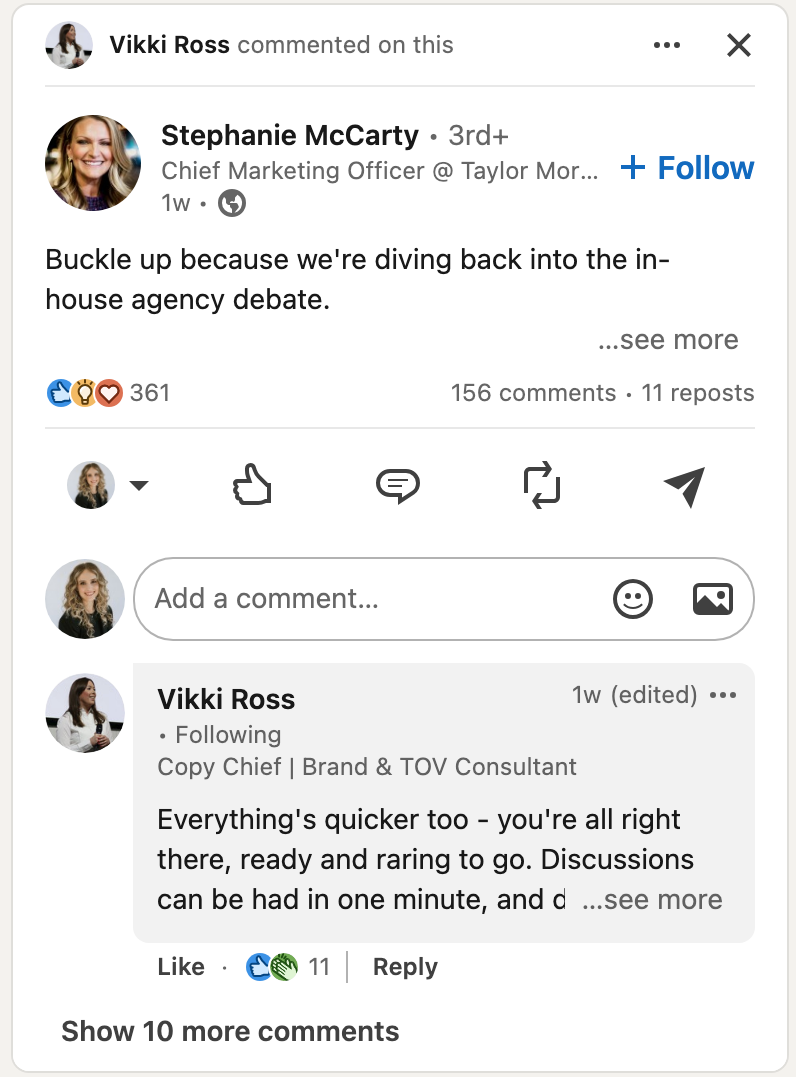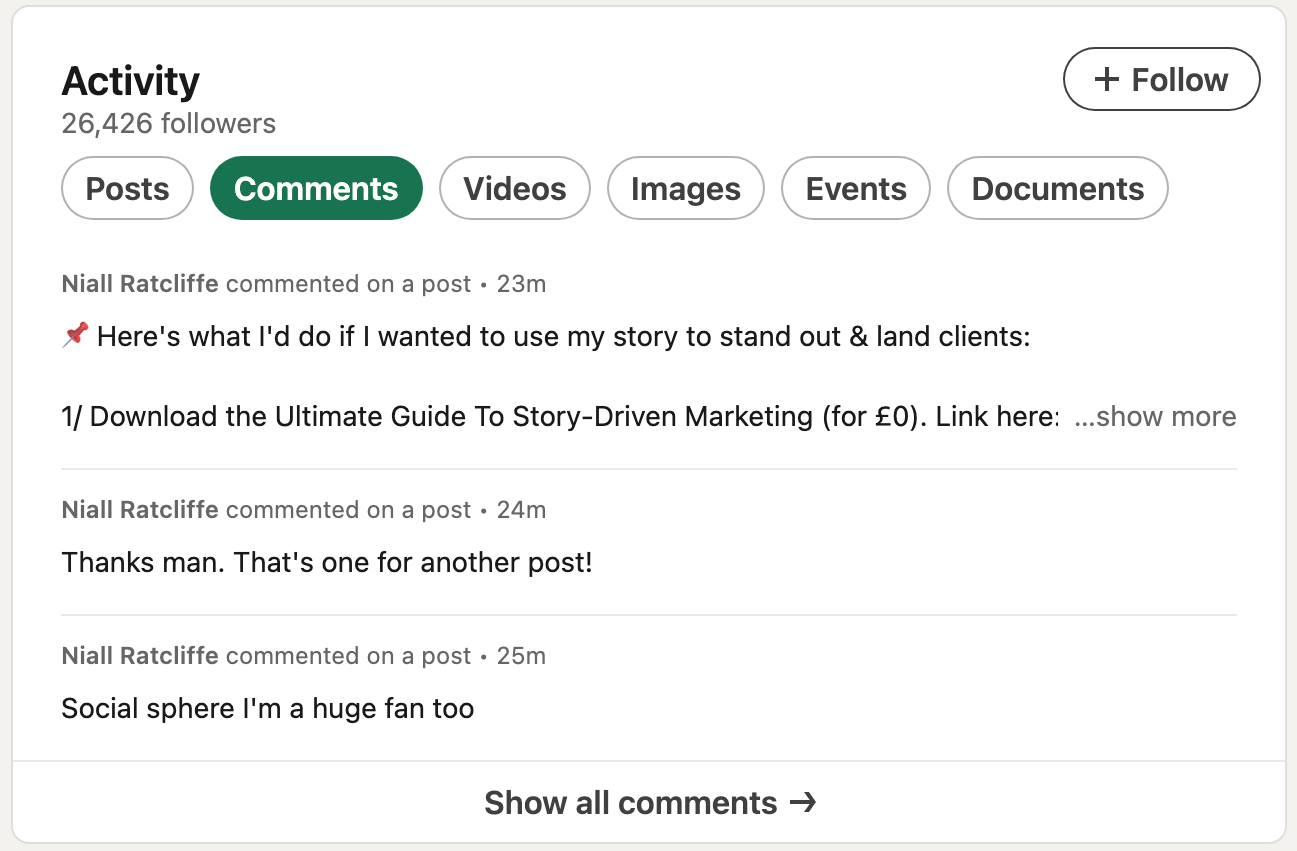What are impressions on LinkedIn, and how do you increase them? LinkedIn is a great place to generate leads, but sorting through your analytics can be confusing.
To help you understand the key metrics of your content’s visibility, I’ll break down LinkedIn impressions and share ways to boost engagement.
What Are Impressions on LinkedIn?
LinkedIn impressions are the number of times your content appears in someone else’s feed. It’s a direct representation of your content’s visibility. LinkedIn impressions are how you measure the number of times the platform shows your content to other people.
The higher your LinkedIn impressions, the more people’s feeds you’re showing up in.
When you create posts and publish them to your LinkedIn page, the platform pushes them out to your followers’ feeds. Based on how your post performs, LinkedIn’s algorithm will continue to show your content to more people. LinkedIn impressions work by counting all of the times your post showed up in someone’s feed.
Even if the same user sees your video post one time and then scrolls past it again, LinkedIn will count that as two impressions.
LinkedIn impressions are different than individual post engagement. This measurement doesn’t include engagement like comments, likes, or shares. LinkedIn users don’t have to engage with your content for it to count as an impression.
Why Are LinkedIn Impressions Important?
LinkedIn impressions are important because they help you understand if your content is reaching a wider audience. The more impressions your posts have, the more LinkedIn users your content is reaching.
LinkedIn impressions can indicate how your content is performing. If your LinkedIn impressions feel low to you, it might be time to try a new posting strategy.
While impressions on LinkedIn are important, they’re not the only measurement. You’ll want to review your engagement metrics in addition to your impressions. Impressions can tell you how many people you’re reaching, but other metrics, like your engagement rate, can tell you how many people are interacting with your content.
Is your target audience interacting with your content after seeing it? Having a high number of impressions but a low engagement rate is a potential red flag for the quality of your posts. This indicates that people are seeing your posts but don’t want to interact with them for whatever reason.
Getting more impressions on your posts but not encouraging engagement isn’t an effective content strategy. If you have a high number of impressions but a low engagement rate, you might need to improve your content quality.

The Difference Between Organic, Viral, and Ad Impressions
Under the umbrella of LinkedIn impressions are viral, ad, and organic impressions. Breaking down and separately analyzing your impressions into these three categories can help you identify opportunities to earn more impressions.
Organic Impressions
Organic impressions are unpaid, authentic impressions that your content received. It’s the number of impressions your content received naturally, on its own, as it regularly showed up in the LinkedIn algorithm. That’s an organic impression.
LinkedIn’s algorithm determines how your content shows up in your followers’ feeds. This organic measurement can show you how your individual posts are performing on their own based on the quality of your content.
Ad Impressions
Ad impressions, or paid impressions, are the number of times your content has appeared in other people’s feeds from your paid advertising efforts.
Reviewing these LinkedIn analytics will be a key component of understanding how your paid ads are performing. Whether you manage your own ads or your clients’ ads, this measurement will tell you if your sponsored content is reaching your target audience.
Viral Impressions
Once your targeted audience starts sharing your content with their followers, you’ll start to receive viral impressions.
Viral impressions are the number of times your content has appeared in other users’ feeds because it was shared by other people.
This important metric will help you understand if you’re reaching a larger audience and engaging them. It’s a direct result of people sharing your content.
How to Increase Impressions on LinkedIn
Now that you know that impressions are an important part of your LinkedIn analytics, how do you increase impressions overall? I’ll share strategies for how to increase LinkedIn impressions below.
Optimize Your LinkedIn Profile
Your LinkedIn profile is your first chance to impress your audience.
You could have the most valuable content on LinkedIn, but does your profile back you up? If someone visits your profile and sees that it’s empty, that might change their previously positive impression of you.
To give yourself an idea of what to include in your own profile, analyze other people’s profiles. When you visit someone’s profile, what do you look at? What are the first things you notice? These will most likely be the same things other people notice when they visit your profile.
When I really enjoy someone’s content, I like visiting their profile to learn more about them. Their headline is usually what draws me in to read more about them after I’ve noticed their posts in my feed. When visiting their profile, I’m reading through their professional and personal experiences to discover more about them.


LinkedIn Profile Basics
These are the basics that your LinkedIn profile should have:
- A profile picture that authentically showcases you as a professional: You don’t have to wear a suit and tie if that doesn’t align with your personality. It should reflect who you are and the work that you do.
- A headline that succinctly explains what you do: Your headline will show up next to your profile picture in each of your posts. Entice people to click on your profile with an intriguing headline.
- The perfect summary in your About section: Summarize what you do and what you have to offer in an engaging About section. This is the first place most people will go to learn more about you after they’ve read your headline and visited your LinkedIn profile.
- Skills: You can list up to 50 skills on your LinkedIn profile to help searchers determine if your talents are a good fit for them. If you’re not sure where to start, check out our guide on which skills to put on LinkedIn.
For the ultimate example of being yourself on LinkedIn, we turn to an unlikely source: Snoop Dogg. The rapper and entrepreneur’s LinkedIn presence discusses his various businesses and unique personality. He’s not pretending to be an overly professional businessman.
What Snoop Dogg joining LinkedIn means for content creators is that it’s even more acceptable to be authentically yourself on this traditionally formal social media platform.
Commenting on LinkedIn
Commenting is a great way to build relationships on LinkedIn. It’s also an effective strategy for helping your posts earn high impressions.
LinkedIn’s algorithm tries to encourage engagement by showing your connections’ comments in your feed. If you’ve ever been scrolling through LinkedIn and noticed a post that says someone “commented on this,” that’s what this is.
Here’s an example:


This means that as people start engaging with your content, your posts can show up in the feeds of people who don’t follow you.
Start by having thought-providing content that invites users to share their opinion. Early interactions are so important for LinkedIn’s algorithm overall, so encourage your audience to comment on your posts.
As people start commenting on your posts, engage back with them. Respond to their comments, ask them questions, and have discussions underneath your posts. This will further help boost your impressions and interaction rate.
When done correctly, you can encourage group discussions in your comment section.
Many creators are starting the conversation in the comment section by putting the LinkedIn link in comments. Instead of including the link at the bottom of a post, creators are putting the link in the first comment. This strategy tells the algorithm that you’re creating social-first content. It also makes it less obvious that you’re trying to take LinkedIn’s traffic to other channels.
Outbound Engagement Strategy on LinkedIn
In the same way that you want people to comment on your posts, other creators also want you to comment on their posts. The good news is that commenting on other people’s posts is also beneficial for your content, too.
Your engagement with other people’s posts helps boost your position in the algorithm. It will also hopefully encourage people to comment on your own posts.
However, this does not mean you should spam other people’s posts with comments. Your interactions should be authentic and thoughtful. Simply commenting, “Nice work,” or “I like this,” isn’t enough.
When your audience visits your profile, they can see every comment you leave. If they see that you’re leaving a string of spam-like comments, that won’t leave a positive impression.


The more valuable your comments are, the more this shows the algorithm and your audience that you’re informed and opinionated on topics they’re interested in.
Post High-Quality Content
The quality of your social media content is one of the key factors affecting LinkedIn impressions. If you’re dissatisfied with your impressions and interaction rate, start by improving the quality of your content.
Content Types
Experiment with different content formats until you find what performs best for you. Trying out a variety of content formats will help you engage with unique users.
As LinkedIn starts offering different formats for content, use it as a strategic opportunity to try something new and reach more people. Start with images, videos, and infographics, and branch out from there.
Here are a few ideas for the different types of content you can create to help earn high impressions on LinkedIn:
- Images
- Infographics
- Documents
- Polls
- Video Posts
- Live events
- Carousels
Carousels are a great way to visually educate your audience on a particular topic. Check out these LinkedIn carousel examples for ideas.
Frequency
Part of having high-quality content includes making sure you post regularly. Your posting frequency is important, but it needs to match the quality of your content.
If you’re posting every day but it’s not relevant content, your post impressions and engagement rate will probably start decreasing. Alternatively, if you’re posting less frequently but have high-quality content, your specific audience will probably reward you for that.
To help keep up with the posting frequency, you can use third party tools like Social Pilot to help you bulk schedule your content. A free social media scheduler can help you seamlessly improve your content strategy.
When you prioritize quality and frequency, you can be on the right track toward success on this professional platform. Additionally, knowing the best and worst time to post on social media can help you maximize your efforts for the times that you do post.


Keywords are a crucial part of an effective content strategy on LinkedIn.
Focusing on keywords throughout your posts on social media is actually more important than hashtags. Hashtags are part of this overall keyword strategy, but they don’t act alone. Social media algorithms are starting to prioritize SEO, which means that each post should focus on keywords overall.
For example, if your keyword is “social media marketing,” you would want to mention this keyword in your graphic and throughout your caption.
Having a large block of hashtags at the end of your post can actually have a negative impact on your content’s reach. Posting so many hashtags under one post can give the algorithm the impression of spam. It’s unlikely that all of your hashtags are highly relevant to your post.
If you’re talking about a specific topic and then include a different hashtag in your post caption, the algorithm isn’t going to pick up your content as highly relevant to the original topic. Narrowing down your hashtags to five or less will help you stay focused as you create each post.
Boosting Impressions on LinkedIn
LinkedIn impressions are important for measuring your content’s performance. With these tips for boosting impressions, hopefully your posts will start to show up in my own feed. I’ll see you in the comment section!
